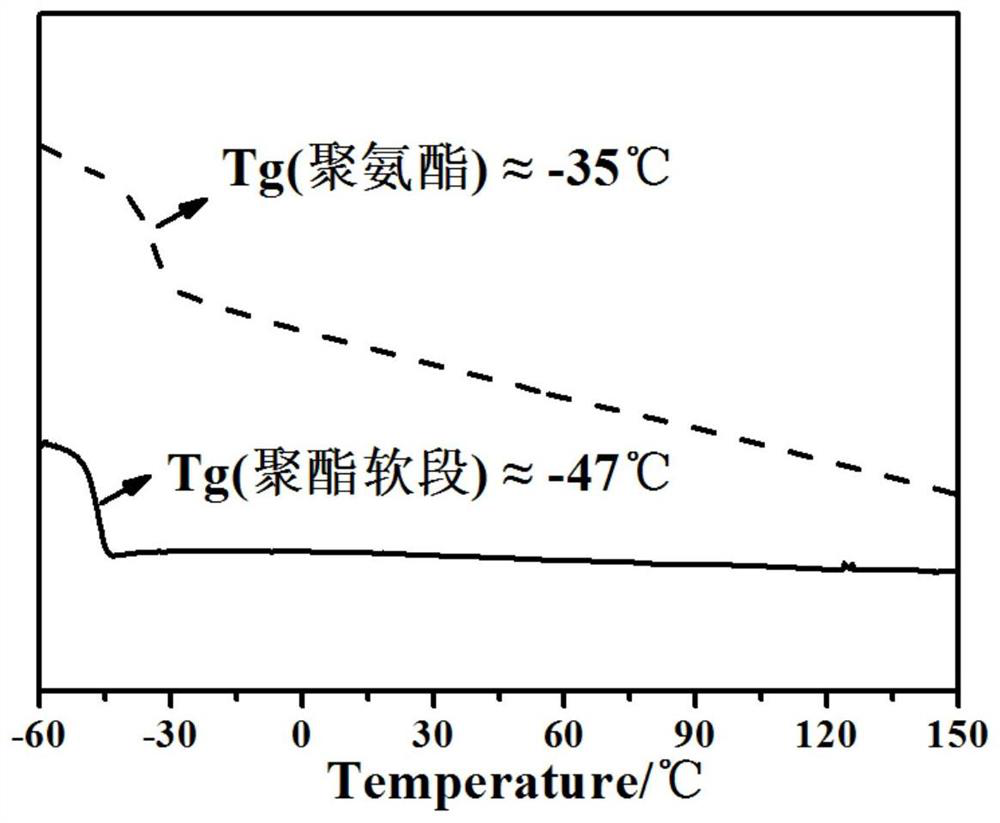Polyurethane elastomer taking bio-based amorphous multi-component polyester as soft segment and preparation method thereof
A polyurethane elastomer and multi-polyester technology, applied in the field of polymer materials, can solve the problems of low temperature resistance and poor flexibility, and achieve the effects of improving elongation at break, wide design window and improving performance
- Summary
- Abstract
- Description
- Claims
- Application Information
AI Technical Summary
Problems solved by technology
Method used
Image
Examples
Embodiment 1
[0045] The preparation method of bio-based polypolyester soft segment: the molar ratio of bio-based 1,3-propanediol, 2,3-butanediol, succinic acid, and sebacic acid is 1.1 / 0.3 / 0.7 / 0.3 (alcohol-acid ratio 1.4:1) was added into a 250mL four-necked flask, heated to 170°C, and esterified for 3 hours; then the catalyst tetrabutyl titanate was added (the amount of the catalyst accounted for 0.03% of the total mass of dibasic alcohol and dibasic acid ), the temperature was adjusted to 220° C., and the vacuum reaction was carried out for 1 hour to obtain a hydroxyl-terminated amorphous polyester with a number average molecular weight of 4000.
[0046] The preparation method of polyurethane prepolymer: In a 100mL four-necked flask, stir the hydroxyl-terminated polyester at 80°C under vacuum for 2 hours, then cool down to 70°C, add a measured amount (polyester soft segment and diisocyanate The molar ratio is 1:2, the soft and hard segment mass ratio is 87 / 13) diphenylmethane diisocyanat...
Embodiment 2
[0050] The preparation method of bio-based polypolyester soft segment: bio-based ethylene glycol, 1,3-propanediol, succinic acid, adipic acid, and itaconic acid in molar ratios of 0.80 / 0.80 / 0.63 / 0.27 / 0.10 (alcohol Acid ratio 1.6:1) was added into a 250mL four-necked flask, heated to 180°C, and esterified for 2 hours; then the catalyst p-toluenesulfonic acid was added (the amount of catalyst accounted for 0.06% of the total mass of dibasic alcohol and dibasic acid) %), the temperature was adjusted to 200°C, and the vacuum reaction was carried out for 2.5 hours to obtain a hydroxyl-terminated amorphous polyester with a number average molecular weight of 5000.
[0051] The preparation method of polyurethane prepolymer: In a 100mL four-necked flask, stir the hydroxyl-terminated polyester at 90°C under vacuum for 3 hours, then cool down to 75°C, add a measured amount (polyester soft segment and diisocyanate The molar ratio is 1:5, the soft and hard segment mass ratio is 79 / 21) 1,5-...
Embodiment 3
[0055] Preparation method of bio-based multi-polyester soft segment: bio-based ethylene glycol, 1,4-butanediol, 1,10-decanediol, succinic acid, and sebacic acid in a molar ratio of 0.75 / 0.6 / 0.15 / 0.8 / 0.2 (alcohol-acid ratio 1.5:1) was added to a 250mL four-neck flask, heated to 190°C, and esterified for 2 hours; then the catalyst tetraisopropyl titanate was added (the amount of the catalyst accounted for 0.04% of the total mass of the dibasic acid), the temperature was adjusted to 210° C., and the vacuum reaction was carried out for 3 hours to obtain a hydroxyl-terminated amorphous polyester with a number average molecular weight of 6000.
[0056] The preparation method of polyurethane prepolymer: In a 100mL four-necked flask, the hydroxyl-terminated polyester was stirred at 95°C under vacuum for 2 hours, then cooled to 80°C, and a measured amount (polyester soft segment and diisocyanate The molar ratio is 1:4, the soft and hard segment mass ratio is 82 / 18) dicyclohexylmethane...
PUM
| Property | Measurement | Unit |
|---|---|---|
| glass transition temperature | aaaaa | aaaaa |
Abstract
Description
Claims
Application Information
 Login to View More
Login to View More - R&D
- Intellectual Property
- Life Sciences
- Materials
- Tech Scout
- Unparalleled Data Quality
- Higher Quality Content
- 60% Fewer Hallucinations
Browse by: Latest US Patents, China's latest patents, Technical Efficacy Thesaurus, Application Domain, Technology Topic, Popular Technical Reports.
© 2025 PatSnap. All rights reserved.Legal|Privacy policy|Modern Slavery Act Transparency Statement|Sitemap|About US| Contact US: help@patsnap.com


